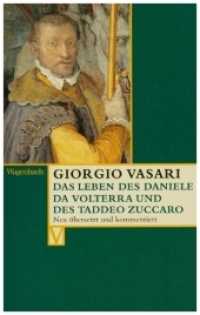- ホーム
- > 洋書
- > ドイツ書
- > Humanities, Arts & Music
- > History
- > middle ages
Description
(Text)
Historical interest is rooted in a quest for identity. The histories of tribes, communities and nations help to define their selfhood, and hence their pasts are inevitably modelled on an implicit program stating the use that an author, a ruler or a community wants to make of real or imagined history. History thus becomes a malleable concept accommodating the requirements of self-definition of individuals, or of social and ethnic groups. It also furnishes the fictional props of the ideologies of states and nascent states that are in need of national mythologies to boost their self-esteem. Under the general title Building the Past the various ends and purposes of historical reconstruction and invention in the late medieval and early modern period are examined in this volume by scholars from various specialised fields. Their contributions are grouped in two sections, Rediscovery of the Past and Construction of National Myths .
Für ein besseres Verständnis des Umbruches vom späten Mittelalter zur Frühen Neuzeit erscheint es wichtig, besser zu verstehen, auf welchem Wege die Eliten dieser Zeit durch die Konstruktion der eigenen Vergangenheit ihre Identität (bzw. die derjenigen Gruppe oder Nation, der sie angehörten) neu definierten. Hier zeichneten sich zwei verschiedene Lösungsstrategien ab, von denen in unterschiedlichem Maße (und teils in enger Verquickung) Gebrauch gemacht wurde: zum einen die Wiederentdeckung der eigenen Vergangenheit, zum anderen die Konstruktion neuer nationaler Mythen. Die thematische Spannweite der in diesem Sammelband vereinten Tagungsbeiträge reicht von der spätmittelalterlichen Chronistik und epischen Dichtung über die Neubewertung mittelalterlicher Architektur bis hin zur Wiedererfindung der Goten zum Zwecke nationaler Mythenbildung und von Überlegungen der Humanisten zu klassischen Vorstellungen von Geschichte und Wissenschaft bis hin zur Symbolik der Königskrone und der Auseinandersetzung mit dem zentralen Ereignis der Varusschlacht.
(Table of content)
Contents/Aus dem Inhalt: Volker Honemann/Martin Gosman: Vorwort - Rudolf Suntrup/Jan R. Veenstra: Introduction - Cynthia M. Pyle: The Renaissance Rediscovery of the Classical Approaches to the World: Reflections on History and Science, Then and Now - Jörg W. Busch: Von der Rückprojektion zur Tatsachenermittlung. Die Wiederentdeckung der Vergangenheit in den oberitalienischen Kommunen des 13. und frühen 14. Jahrhunderts - Roger Mason: From Chronicle to History: Recovering the Past in Renaissance Scotland - John Scattergood: Thomas Wyatt's Epistolary Satires and the Consolations of Intertextuality - Nine Miedema: Das 'Ambraser Heldenbuch' und der Theuerdank . Mittelalterliche Epik und ihre Wiederverwendung am Hof Maximilians I. - Maryvonne Hagby: Die Königstochter von Frankreich des Hans von Bühel. Ein Beispiel nicht-gelehrter Vermittlung historischen Wissens im Spätmittelalter - Kees van der Ploeg: Transformations of Meaning in Medieval Architecture - Alan Swanson: Re-Inventing the Goths: The Trajectory of an Idea - Kees Dekker: Ancient Laws and Early Modern Identities: The Myth of the Lex Salica - Wout Jac. van Bekkum: The Creation of the Myth of Creation in Modern Judaism - Graeme Small: Local Elites and 'National' Mythologies in the Burgundian Dominions in the Fifteenth Century - Kees Teszelszky: A Holy Crown for a Nation. The Symbolic Meaning of the Holy Crown of Hungary and the Construction of the Idea of a Nation - Jennifer Britnell: Conflict of Image? The Most Christian King makes War on the Pope - Volker Honemann: Johannes Cincinnius, Van der niderlage drijer legionen (1539). Die Varusschlacht in der Sicht eines westfälischen Humanisten. Mit einem Faksimile des Textes.








